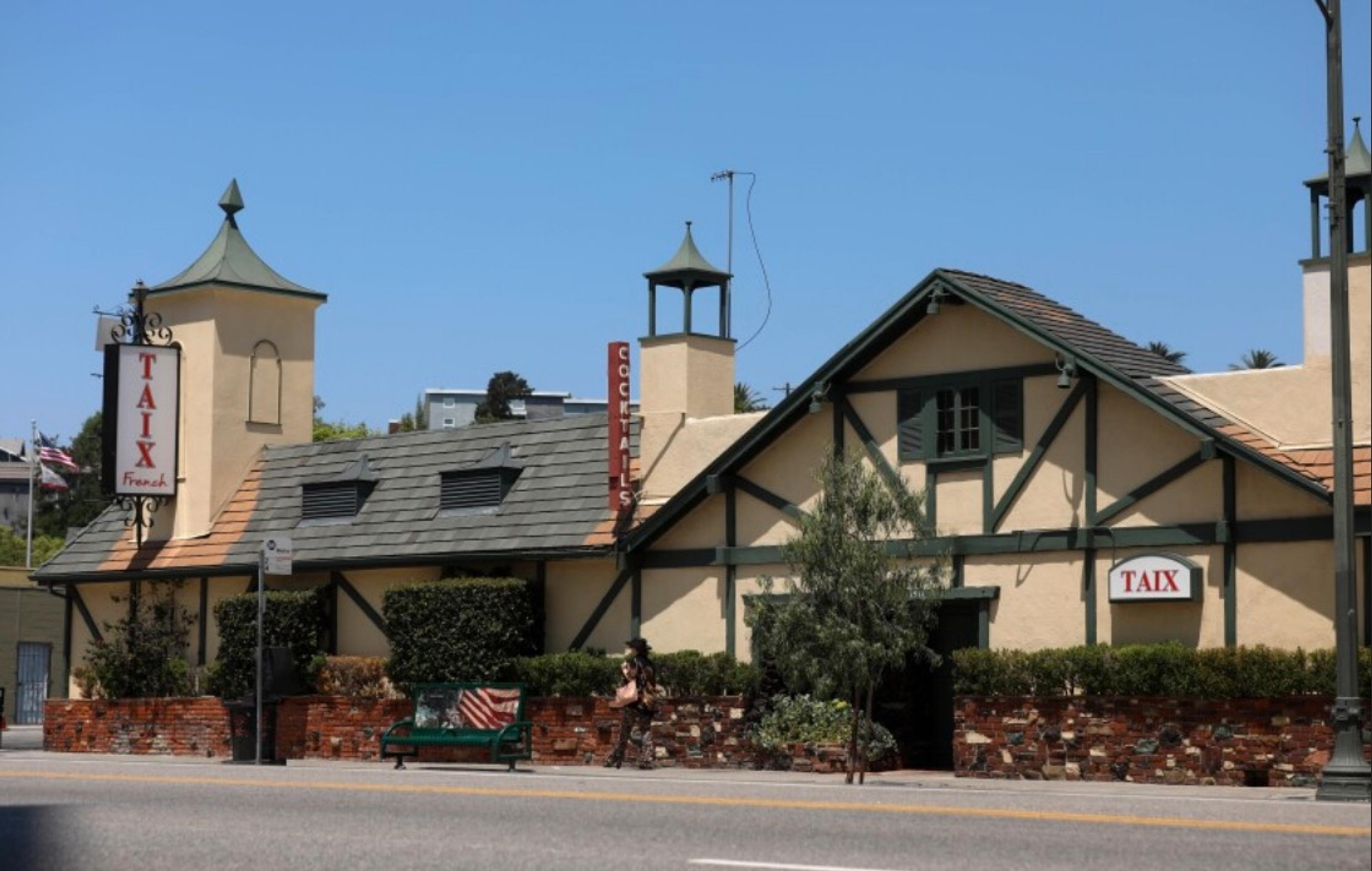So you may remember my “Everything You Always Wanted to Know About Taix (But Were Afraid to Ask)” post from September. Of course, since you read this blog, you’ve probably already seen the recently-released renderings of Taix’s forthcoming replacement, but I would be remiss in my duties were I not to make mention of them here. So. Remember what I said in September’s post about how you’d have to have a dead soul to not be charmed by Taix’s faux-French village vernacular? Well, you’d have to be born with no soul to love this:
A magical pairing of dirty stucco and mustard-beige
Missed Taix? It’s over there:
No no, down there, next to my favorite shop, Retail
Now I’m not implying that the good people at Togawa-Smith-Martin have no souls. I’m sure they cast reflections in mirrors and _everything_. It’s just that those people who get hot for their “brown stack o’ boxes with metal parts and some balconies” style, those people I worry about. But such people don’t exist, I hear you say, and you are correct. Even the Curbed commenters, wetting themselves with glee over the destruction of Taix, admit that this blah-dern blandmark embarrasses the lot of us. They also admit that the new Taix will not succeed; without the charm of its architecture, and the ambience of its interior, it will fail worse than the French agricultural harvest of 1788. And we all know how that turned out.
Dear Lord I fell asleep just posting a picture of it. It’s like the Colin Robinson of architecture.
What, then? Are we resigned to her destruction? Perhaps not. There is, after all, Les Amis de Taix, dedicated to her retention and preservation (their petition is here). Esotouric has a fascinating theory that Holland Group purposely turned the destruction and resurrection of Taix into a trainwreck just to sink the project, a big fat write-off as we head into an economic slowdown being, you know, better than nothing. But, I hear you say, you can’t possibly want to stop a project like this, because housing! Oh you and your bizarre strange-bedfellow propaganda from Billionaire Fatcat Developers and best pals Big Government Leftist Ideologues. Who tell us how we’re to live, when they don’t even live here—Clyde Holland lives in Vancouver and Scott Wiener lives in San Francisco (ok, maybe not such strange bedfellows). Besides, Holland Residential is famous for illegally Airbnb’ing its units. True, this they have denied and responded by saying “well, our units are rented by corporate clients and THEY Airbnb them, not us!” Yes, well, either way, I’m sure we have therewith ended the housing crisis, and good for all of us. Ultimately, Taix must be destroyed because its architecture connotes “little European village.” It positively _reeks_ of the wholesome and virtuous. It’s not popular to make value judgments extolling the positive aspects of European culture these days: it’s hip as hell to hate on Europe as hard as you possibly can—well, _old_ Europe anyway. God forbid something as simple as some half-timbering might make you meditate on truth, beauty, devotion, tradition; all anathema to the modern world. I’m surprised people aren’t protesting it. And Taix has whimsy. Gads, people today sure hate whimsy. (I mean I know millennials are supposed to be a joyless bunch but enough already. Embrace whimsy, ya knuckleheads!) Whither Taix? It’s going to be a strange and fascinating ride…as is everything in this deeply polluted world. For which I have nothing but hope. Stay tuned.
About Nathan Marsak
NATHAN MARSAK says: “I came to praise Los Angeles, not to bury her. And yet developers, City Hall and social reformers work in concert to effect wholesale demolition, removing the human scale of my town, tossing its charm into a landfill. The least I can do is memorialize in real time those places worth noting, as they slide inexorably into memory. In college I studied under Banham. I learned to love Los Angeles via Reyner’s teachings (and came to abjure Mike Davis and his lurid, fanciful, laughably-researched assertions). In grad school I focused on visionary urbanism and technological utopianism—so while some may find the premise of preserving communities so much ill-considered reactionary twaddle, at least I have a background in the other side. Anyway, I moved to Los Angeles, and began to document. I drove about shooting neon signs. I put endless miles across the Plains of Id on the old Packard as part of the 1947project; when Kim Cooper blogged about some bad lunch meat in Compton, I drove down to there to check on the scene of the crime (never via freeway—you can’t really learn Los Angeles unless you study her from the surface streets). But in short order one landmark after another disappeared. Few demolitions are as contentious or high profile as the Ambassador or Parker Center; rather, it is all the little houses and commercial buildings the social engineers are desperate to destroy in the name of the Greater Good. The fabric of our city is woven together by communities and neighborhoods who no longer have a say in their zoning or planning so it’s important to shine a light on these vanishing treasures, now, before the remarkable character of our city is wiped away like a stain from a countertop. (But Nathan, you say, it’s just this one house—no, it isn’t. Principiis obsta, finem respice.) And who knows, one might even be saved. Excelsior!””
Nathan’s blogs are: Bunker Hill Los Angeles, RIP Los Angeles & On Bunker Hill.
